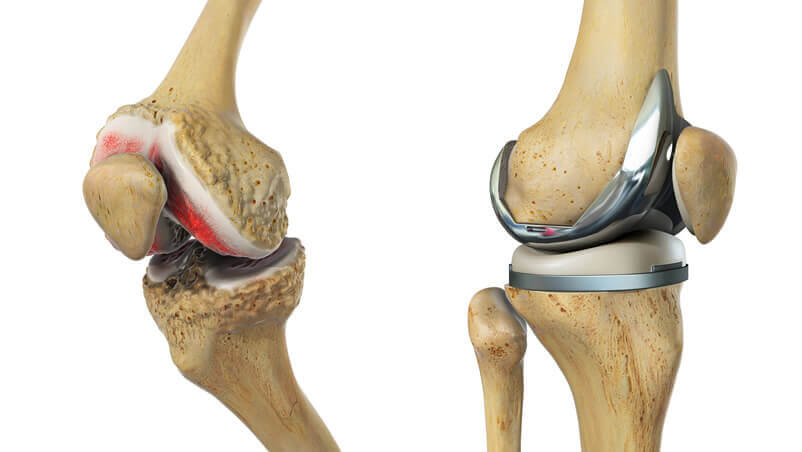Knee Replacement Surgery
Knee Replacement Surgery
Knee replacement surgery is a type of arthroplasty. Arthroplasty means “joint surgical repair,” and it refers to the surgical reconstruction and replacement of damaged joints with artificial body components, or prosthetics.
When the articular cartilage in the knee becomes damaged or worn, the knee becomes uncomfortable and difficult to move. The bones rub and press together instead of moving over each other. With a prosthesis, the patient will have less pain and the knee will function normally.

Which condition needs knee replacement surgery?
The operation is commonly performed for three reasons:
Osteoarthritis: This type of arthritis develops with age and is caused by normal wear and strain on the knee joint. It primarily affects patients over the age of 50, but younger people may be affected as well.
Osteoarthritis is characterised by inflammation, joint degradation, and the slow and final loss of cartilage. The cartilage wears away over time, causing the bones to rub together. To compensate, the bones often thicken, but this causes extra friction and pain
Rheumatoid arthritis, also known as inflammatory arthritis, causes the membrane surrounding the knee joint to thicken and inflame. Chronic inflammation causes damage to the cartilage, producing pain and stiffness.
Post-traumatic arthritis occurs as a result of a severe knee injury. When the bones around the knee rupture or the ligaments tear, the knee cartilage is affected.
Who is the right candidate for knee replacement surgery?
Knee surgery may be appropriate for patients who have:
- Severe knee discomfort or stiffness that prohibits individuals from performing daily jobs and activities like walking, going upstairs, getting in and out of cars, and getting up from a chair.
- Moderate but persistent knee discomfort that persists while sleeping or resting.
- Chronic knee inflammation and edema that does not go away despite medicine or rest.
- Knee deformity is characterised by a visible arch on the inside or outside of the knee.
- Depression is caused by an unwillingness to engage in daily or social activities.
- If all other treatment options have failed, surgery may be the best option.
Types of knee replacement surgery
Total knee replacement (TKR): This surgery replaces both sides of the knee joint. It is the most commonly used method.
The operation lasts between 1 and 3 hours. The person will have less discomfort and better mobility, but scar tissue will form, making it harder to flex and bend the knees.
Partial knee replacement (PKR): This procedure replaces only one side of the knee joint. The incision is smaller since less bone is removed, but it does not last as long as a total replacement.
PKR is appropriate for patients who have only one area of their knee damaged. Post-operative rehabilitation is simpler, there is less blood loss, and there is a lesser risk of infection and blood clots.
The hospital stay and rehabilitation period are typically shorter, and there is a higher chance of more spontaneous mobility.
Protocol for knee replacement surgery
- Because knee arthroplasty is a major surgery, preoperative preparation, medical consultations, and physical evaluations typically begin a month before the scheduled date of the procedure.
- Preparatory and diagnostic testing will include a blood count, an examination of how the blood clots, electrocardiograms (ECGs), and urine tests.
- Generally, surgery is performed under general, spinal, or epidural anaesthesia.
- During the treatment, the orthopaedic surgeon will remove the damaged cartilage and bone before positioning the new implant, which could be composed of metal, plastic, or both, to restore the knee’s alignment and function.
Recovery time after knee replacement surgery
- There will be discomfort, but a day after the treatment, medical professionals will advise patients to get up and walk around, usually with the use of a walker. It is critical to follow the rehabilitation methods.
- The goal of physical therapy sessions is to strengthen the knee. These may be uncomfortable, but they dramatically lower the risk of subsequent complications.
- Patients who do not have care at home may need to stay in the hospital for an extended period of time.
- Recovering following a knee replacement surgical procedure might take up to three months.
- Patients can return to work after 6 to 8 weeks. Physical therapy may be provided for a period of three months.
- Patients must follow the advice of doctors, nurses, and physical therapists.
For any knee pain or joint pain, contact our orthopedic experts at KK speciality clinic and hospital in Mumbai.
